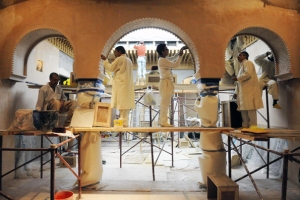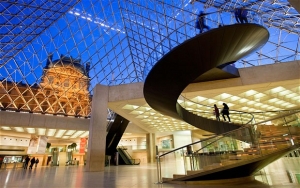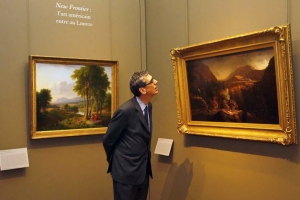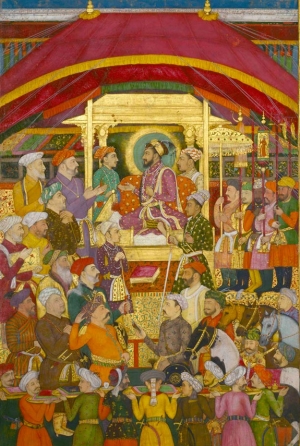|
Displaying items by tag: Islamic Art
The British Museum will open a new gallery in 2018 dedicated to a broad swath of Islamic art, the museum announced.
Set in a pair of currently closed galleries in the heart of the museum, the Albukhary Foundation Gallery of the Islamic World will include sections dedicated to Islamic art until around 1500, and to artifacts from three 16th-century Islamic dynasties — the Ottoman, the Mughal and the Safavid. A selection of contemporary artwork will also appear – including works from “The Invisible Enemy Should Not Exist,” a series by the American artist Michael Rakowitz in which he recreated artworks looted from the National Museum of Iraq after the American-led invasion of 2003.
The Los Angeles County Museum of Art announced Tuesday its intention to lend more than 130 pieces of its Islamic art collection to a museum under construction in Saudi Arabia.
The King Abdulaziz Center for World Culture, scheduled to open in 2016, will show the LACMA pieces along with a new acquisition, a never-before shown 18th century room from a home in Damascus, Syria.
Between wooded ravines north-east of downtown Toronto in Canada, a cone jutting upwards from beige limestone shares a seven-hectare site with a massive rectangle in elegant white granite that resembles an open box. Both structures form a bridge between the tradition and culture of the Islamic world and the present and future of Canada.
The Aga Khan Museum, the 4,370-square-metre chiselled white form, opened to the public on Thursday. Clad in Brazilian granite, it houses the collection of the Aga Khan, the imam of the Ismaili community, in a structure designed by the Japanese architect Fumihiko Maki.
The first museum in North America devoted to Islamic arts and culture is due to open on 18 September in an unlikely place: the Don Mills suburb of Toronto, Canada. The Aga Khan, the spiritual leader of the Ismaili Muslim community, philanthropist and chairman of the Aga Khan Development Network, is the founder of the $275 million complex, which also includes a community center and gardens covering 753,473 sq. ft.
Eight years in the making, the 113,000 sq. ft. Aga Khan Museum seeks to increase knowledge and understanding of Muslim civilizations through the arts of the Islamic world.
The Walters Art Museum announced Monday that it's been awarded $913,000 in grants to support renovations and exhibitions at the museum, including a special show on Islamic art scheduled to open next year.
That sum is made up of six individual donations — four from government agencies and two from private foundations — Walters spokeswoman Mona Rock said in a news release.
The bulk of the money, $500,000 will be used to support "Pearls on a String: Art and Relationship in the Islamic World," which is scheduled to open in the fall of 2015.

This May, the Dallas Museum of Art will welcome one of the most comprehensive collections of Islamic art in private hands. The works will be on long-term loan to the museum and will transform the institution’s Islamic art collection into the third largest of its kind in North America. The collection’s signature work, a rock crystal pitcher, will go on view at the Dallas Museum this year, followed by more than 50 works in 2015.
The Keir Collection of Islamic art was assembled over five decades by the late art collector Edmund de Unger. According to museum officials, the collection “is recognized by scholars as one of the world’s most geographically and historically comprehensive, encompassing almost 2,000 works in a range of media that span 13 centuries of Islamic art-making.” The Keir Collection, which is named after the 18th-century British mansion where is was housed, includes textiles, carpets, ceramics, rock crystal, metalwork and works on paper from the western Mediterranean to South Asia.
The lender is covering all costs related to the packing and shipping of the collection to the Dallas Museum of Art, along with any conservation that is required and any print publications the museum plans to produce. The museum was not charged a fee for acquiring the collection, but it will pay to have the works insured as well as any costs relating to the display of the objects.

The Metropolitan Museum of Art in New York announced that on January 18, 2013, the number of visitors to the New Galleries for the Art of the Arab Lands, Turkey, Iran, Central Asia, and Later South Asia hit the one million mark. The renovated galleries, which reopened to the public on November 1, 2011, draw approximately 2,550 patrons each day.
The Met’s Islamic Art collection, which is comprised of over 1,200 works and spans 1,300 years, is considered one of the most comprehensive collections of its kind. The holdings are presented in 15 different galleries, the result of an eight-year project that included renovations, expansions, and reinstallations.
Thomas P. Campbell, Director and CEO of The Metropolitan Museum of Art, said, “Since these galleries reopened in their new configuration just over a year ago, we have been truly gratified by the exceptional interest that our visitors – both local and international – have taken in this newly conceived presentation of Islamic art.”
To commemorate the Met’s milestone, the one-millionth visitor to the Islamic art galleries received a catalogue of the collection.

The Louvre, Centre Pompidou, and Musee d’Orsay all reported record attendance numbers for 2012. Recent expansions, newly unveiled renovations, and impressive exhibitions are responsible for beckoning troves of visitors from across the world to the Parisian institutions.
The Louvre, which is the most-visited museum in the world, summons bigger crowds each year. 2012 marked the largest attendance figures ever recorded for the institution with nearly 10 million visitors this year. Expanded Islamic art galleries and a spate of well-received temporary exhibitions were of particular interest to visitors. In fact, they helped boost attendance 29-percent from 2011. Exhibition highlights at the Louvre in 2012 included a show devoted to Thomas Cole (1801-1848) and the birth of American Landscape painting, the presentation of Leonardo da Vinci’s (1452-1519) masterwork, The Virgin and Child with Saint Anne, and an exhibition of Raphael’s (1483-1520) later works, which he produced in Rome.
The Centre Pompidou, which specialized in modern and contemporary art, welcomed over 3.8 million visitors in 2012, a 6-percent increase from 2011. The Centre Pompidou held three major retrospectives this year, which helped raise visitor numbers. An exhibition devoted to Henri Matisse (1869-1954) titled Matisse, Paires et séries brought 495,000 visitors; a Gerhard Richter (b. 1932) retrospective brought 425,000; and a show of Spanish surrealist Salvador Dalí’s (1904-1989) works has seen approximately 6,700 visitors per day since it opened on November 21.
After attendance figures declined from 2008 to 2010, it appears that the Impressionist institution, the Musée d’Orsay, has bounced back with 3.6 million visitors this year. A 15-percent increase from last year, the boosted attendance numbers were likely the result of the reopening of renovated gallery spaces and a major Edgar Degas (1834-1917) exhibition, which brought 480,000 visitors. The current exhibition, Impressionism and Fashion, is expected to see 500,000 guests before closing on January 21, 2013.

After twelve years at the helm of the world’s busiest museum, Henri Loyrette announced that he will leave his post at the Musée du Louvre in April of 2013. Before becoming the president and director of the Louvre, Loyrette served as the first curator and then the director of Paris’ Musée d’Orsay from 1994 to 2001 and has served as France’s chief curator of heritage since 1975. Loyrette has already informed the president of France, François Hollande, and the country’s minister of culture of his departure.
The Louvre attracts more visitors each year than any other institution in the world and Loyrette has managed to keep that number on the rise. In fact, the number of visitors has almost doubled under Loyrette’s leadership; 5.1 million patrons were reported in 2001 and by the end of 2012, almost 10 million people will have visited the Louvre this year.
However, Loyrette did much more than increase attendance during his time at the Louvre. He is responsible for implementing the museum’s contemporary art program and has organized exhibitions by Cy Twombly (1928-2011), Anselm Kiefer (b. 1945), and many other renowned modern artists. Loyrette employed a new policy that relied on crowd-sourced fundraising and launched a number of successful public campaigns that asked art enthusiasts to help the museum make important acquisitions. Loyrette also oversaw the opening of the Louvre’s outpost in the northern city of Lens as well as the expansion of the museum’s Islamic art galleries, which opened earlier this year.
Loyrette will no longer be in charge when the Louvre’s outpost in Abu Dhabi opens. The controversial project stirred debate in the French art world as Abu Dhabi has paid nearly $1.3 billion to use the Louvre name for thirty years and to gain access to the museum’s collection during that time. Designed by French architect Jean Nouvel, the Abu Dhabi location is slated to open in 2015.

(Los Angeles, March 15, 2011)—The Los Angeles County Museum of Art (LACMA)presents Gifts of the Sultan: The Arts of Giving at the Islamic Courts, a major international loan exhibition, which explores Islamic art through the universal tradition of gift giving. Many of the most spectacular and historically significant examples of Islamic art can be classified as gifts, a number of which will be brought together for the unique purpose of this exhibition to demonstrate the integral and complex nature of gift exchange in the Islamic world. Organized by LACMA with support from the Museum of Fine Arts, Houston (MFAH), Gifts of the Sultan spans the eighth through nineteenth centuries and features more than 250 works of art representing a rich variety of media from collections in America, Europe,and the Middle East. Following its presentation at LACMA (June 5–September5, 2011), Gifts of the Sultan travels to the MFAH (October 23, 2011–January 15, 2012).
“We hope that Gifts of the Sultan will introduce new audiences to Islamic art by focusing on a practice shared by all cultures—gift exchange,” said Linda Komaroff, exhibition curator and LACMA curator of Islamic Art and department head of Art of the Middle East. “We all share a sense of delight in receiving gifts, and the many sumptuous objects presented in this exhibition will allow visitors to imagine themselves as the fortunate recipients.”
Exhibition Overview
Gift giving was a fundamental activity at the great Islamic courts for various purposes: to further diplomatic and political ambitions; as reward for services rendered; to celebrate annual events like the New Year or more personal occasions such as weddings and birthdays; and as expressions of piety, often associated with the construction or enhancement of religious monuments. Made of rare and precious materials and commissioned from the best artists and craftsmen of the day, these gifts came in many forms. Gifts of the Sultan brings together a brilliant array of diverse works including silk carpets and textiles woven with golden thread; jewelry and objects fashioned of precious metal; containers fashioned of jade, ivory, or rock crystal; elaborately illustrated manuscripts and richly illuminated Qur’ans; enameled and gilded glass; carved and inlaid wooden furnishings; and jewel-encrusted arms and armor.
Gifts of the Sultan will show that many works were not straightforward gifts; rather their gift status is only revealed by unraveling their life stories, which tell how they were viewed or received, which was very often beyond the context of their original creation. The exhibition will also demonstrate the cross-cultural interactions that took place between Islam and Byzantium, and with western European and East Asian courts, as the exchange of luxury objects illustrates a central process by which artistic forms and ideas were circulated, emulated, and assimilated.
Exhibition Organization
Gifts of the Sultan will be organized in three broad sections: personal gifts, pious donations, and state and diplomatic gifts. The first includes more intimate items such as objects of personal adornment in the form of jewelry, belts, and garments; precious yet utilitarian pieces such as vessels of gold, silver, porcelain, and jade; along with paintings, albums, and manuscripts. The second section highlights pious donations, encompassing architectural elements, furnishings, and manuscripts of the Qur’an that were part of a religious institution’s endowment, the endowment deed itself, and works, often of a secular nature, that were specifically gifted to a mosque or shrine. The third and largest section features works that were made for or kept in royal treasuries, representing a broad array of types and materials ranging from rock crystal pieces and courtly regalia to places of habitation such as a palace façade or a tent. A full-size silk and gold-embroidered Ottoman field tent presented to Catherine the Great from the Hermitage collection will provide the focal point of this section.
The exhibition will also include a small contemporary component presenting the work of Sadegh Tirafkan, Shahzia Sikander, and Ahmed Mater. These three innovative artists, who have roots in the Islamic world and draw inspiration from their own cultural traditions, have been commissioned to produce new work interpreting the theme of Gifts of the Sultan.
Exhibition Highlights
Approximately fifteen objects from LACMA’s permanent collection will be on view in the exhibition, such as the famed and rarely exhibited Ardabil Carpet (1539–40), which was a royal gift to the Safavid shrine at Ardabil, in northwestern Iran. Other key works of art drawn from international collections that will be on display include two spectacular pairs of oversize gold bracelets from eleventh-century Syria that were perhaps dowry gifts; pages from a beautiful Mughal album, given by an Indian prince to his beloved wife; a group of enormous gold-embroidered textiles sent by Ottoman sultans to embellish the Ka`ba, in Mecca; and a fourteenth-century enameled and gilded glass mosque lamp, which was made for one of Cairo’s religious complexes but was subsequently gifted by the Khedive of Egypt to King Leopold of Belgium for the inauguration of the Suez Canal in 1869.
Catalogue
The exhibition catalogue, published by LACMA and Yale University Press, represents the collective scholarship of an international team ofcontributors, led by exhibition curator Linda Komaroff. The elaborately illustrated book examines the complex interplay between artistic production and gift-based patronage.
|
|
|
|
|